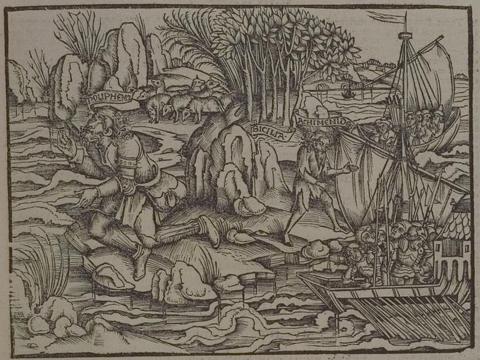Annotations
On the right, Achaemenides [Achimenides], a warrior from Ithaca who was left behind by Odysseus, approaches the Trojan ships. He reaches out as a suppliant (592-99) and begs them to take him away from the island of the Cyclopes (600-54). He is dressed in rags (593). The Trojans look upset and concerned. On the left, blind Polyphemus sits facing away from Achaemenides and the Trojans. Behind him his flock of sheep graze; sheep are an important element in Odysseus's encounter with Polyphemus. In Vergil's understanding of the world of Odysseus, the Cyclopes live on the island of Sicily. (Katy Purington)
Woodcut illustration from the “Strasbourg Vergil,” edited by Sebastian Brant: Publii Virgilii Maronis Opera cum quinque vulgatis commentariis expolitissimisque figuris atque imaginibus nuper per Sebastianum Brant superadditis (Strasbourg: Johannis Grieninger, 1502), fol. 204r, executed by an anonymous engraver under the direction of Brant.


Sebastian Brant (1458–1521) was a humanist scholar of many competencies. Trained in classics and law at the University of Basel, Brant later lectured in jurisprudence there and practiced law in his native city of Strasbourg. While his satirical poem Das Narrenschiff won him considerable standing as a writer, his role in the transmission of Virgil to the Renaissance was at least as important. In 1502 he and Strasbourg printer Johannes Grüninger produced a major edition of Virgil’s works, along with Donatus’ Life and the commentaries of Servius, Landino, and Calderini, with more than two hundred woodcut illustrations. (Annabel Patterson)